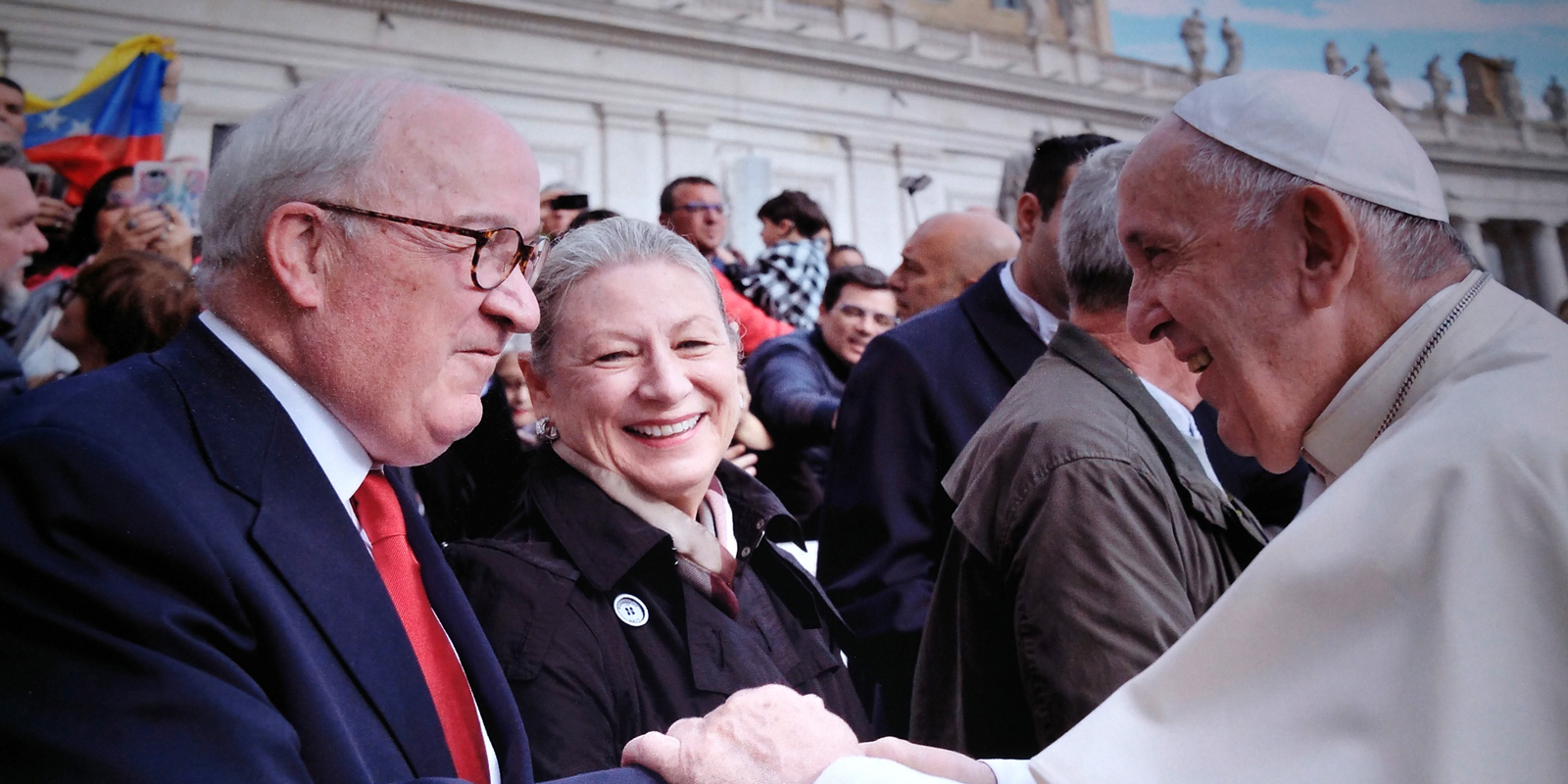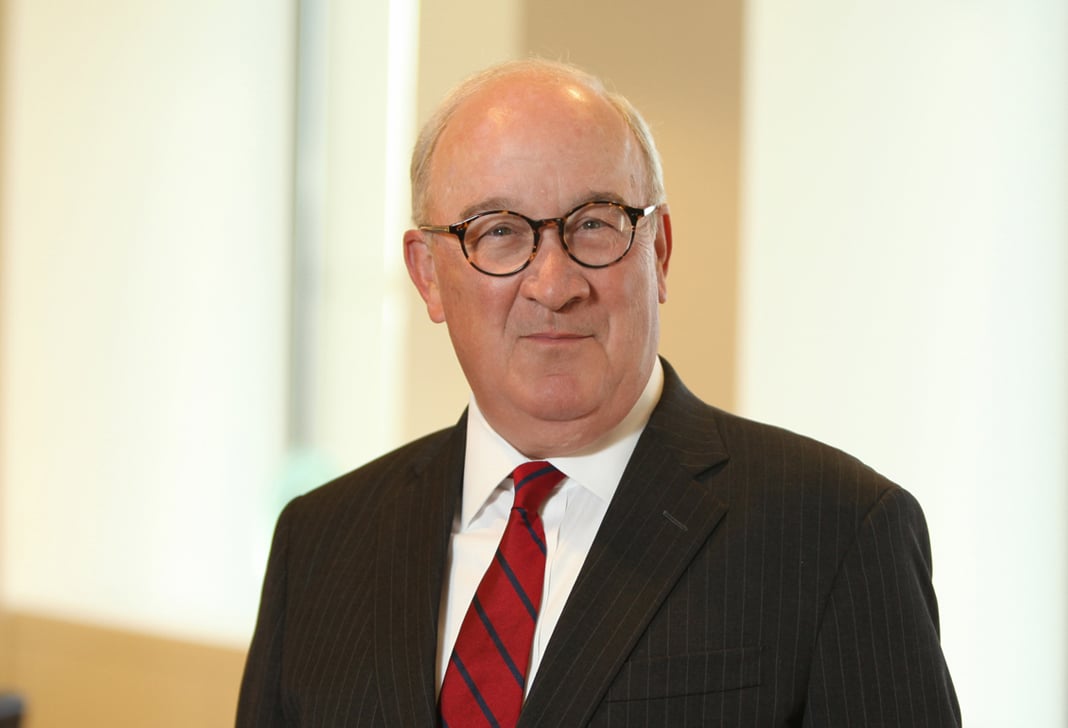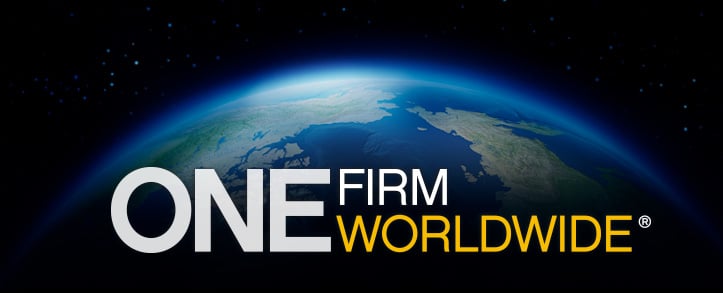
ONE Connection | Mickey Pohl: The Remarkable Career of a Jones Day Lifer
Mickey Pohl has a knack for being in the middle of things, for finding good fortune, for making connections with prominent people—clients, colleagues, clergy—that inevitably lead to other valued connections. And travel. His itinerary of late included a trip to Rome, attending the viewing of the late Pope Francis during funeral proceedings, a trip to England with his wife Kaya for a dinner with King Charles, and watching former Jones Day Managing Partner Steve Brogan receive an honorary doctorate at the University of Notre Dame.
Earlier this month, he played a round of golf with major champion Rory McIlroy at Oakmont Country Club near Pittsburgh, the site of this year's U.S. Open Golf Championship. In the fall, he's headed to Pohnpei in Micronesia to teach trial advocacy classes.
"It's like Walter Mitty stuff," says Mickey. "Tony Dias used to call me Forrest Gump, because things just fall out of the sky and hit me."
It helped that during his four decades as a Jones Day partner, Mickey was a world-class litigator, which, among many other accolades, landed him in Legal 500's inaugural Hall of Fame in 2017. These days, Mickey is of counsel, resident in the Pittsburgh Office, the office he opened for the Firm in 1989. It's been a great run. But his long tenure at a major global law firm was anything but guaranteed.
A Kid from Erie
Paul Michael "Mickey" Pohl grew up in Erie, Pennsylvania. His plans to go from Princeton, from which he graduated in 1970, directly to law school, were interrupted by the Vietnam War draft lottery in December 1969. He got a low draft number. Although he had been rejected from a Navy OCS program because of poor eyesight, he learned that he was still draftable. When his number came up and he was going to be drafted into the Army, he joined the Marines instead because he thought it would be "more exciting."
In 1972, as the U.S. military was reducing its presence in Vietnam, Mickey's two-year enlistment was shortened by a few months. While he had not planned to go to the University of Pittsburgh Law School, because he was a Pennsylvania resident and a veteran, he learned he could begin law school while he was still technically on active duty. Thus, he was Corporal Pohl, USMC, one day and a 1L the next.
By his third year of law school, Mickey was the Editor-in-Chief of the Law Review and was working as an extern for a judge on the U.S. Court of Appeals for the 3rd Circuit. He had always planned to return to Erie and, as he says, have a small firm with a practice like Atticus Finch in To Kill a Mockingbird. He was the first lawyer in his extended family, knew very few lawyers, and knew even less about law firms.
Mickey grew up in Erie's inner city on what he called the "factory side of town." In high school, he worked in an old-style gas station. While working nights he learned the basics of servicing cars and especially how to fix and change tires. Little did he know that this skill would be a great asset after he arrived at Jones Day.
While still in law school, Mickey visited his parents for the holidays in Erie. There he spoke to an old family friend, Donald Alstadt, who years earlier had grown up in the same neighborhood and gone to the same high school, and had since become president of Lord Manufacturing Company. Alstadt was a brilliant scientist and inventor. He told Mickey that as the company was growing in the late 1960s, he and company chairman Thomas Lord had decided that for major matters they wanted to have the "best" law firm in the world. He said they expected to find what they were looking for in New York, or maybe Chicago, but after much searching, they had become convinced that the best law firm in the United States was, as it was known then, Jones, Day, Cockley & Reavis in Cleveland. Alstadt encouraged Mickey to try to get a job at Jones Day. Jones Day then seemed huge—almost 170 lawyers.
Mickey knew no one at the Firm. Jones Day had no lawyers from Pitt Law School and did not interview at Pitt. When Mickey told Alstadt that getting an offer from Jones Day did not seem likely, Alstadt told him that Frank Heath, a Jones Day partner who headed the Firm's Labor Practice, was on Lord's board of directors and that he would arrange a meeting. When they first met, Mickey told Heath, "I really appreciate the chance to meet you but I know that you have no one from Pitt Law School at your Firm and I suspect that my enthusiastic friend Mr. Alstadt is pressing you to talk to me."
Heath set him straight. He told Mickey that in recruiting and hiring Jones Day does not "go through the motions." They hire on merit, not on who is a friend of a client. He was meeting with Mickey based on the strength of Mickey's record and he said, "If you are serious about the practice of law at the highest level, you owe it to yourself to come to Cleveland, find out about Jones Day, and let us decide if you merit an offer."
Mickey interviewed at Jones Day, received an offer, and after a one-year clerkship on the Pennsylvania Supreme Court, he and Kaya, his high school sweetheart he had married in 1970, moved to Cleveland and Mickey started at the Firm in September 1976.
Quick Jump to the Big Leagues
After only a few months at the Firm, Jones Day was retained to represent General Motors in a massive federal grand jury investigation that the IRS had triggered relating to how GM accounted for "expense materials." The team was headed by Hugh Calkins, a brilliant Harvard-educated lawyer who headed Jones Day's Tax Practice, and George Moscarino, a former county prosecutor who had extensive experience with grand juries, criminal prosecutions, and was one of the best ever at developing facts. A large team was assembled and fact-finding began at every one of GM's U.S. divisions. For almost every week for 13 months, Mickey and others traveled to Detroit.
After a few years doing mostly grand jury work, Mickey was concerned that he was not getting enough trial or courtroom experience. He told Pat McCartan (the future Managing Partner) that he was considering going after a job in the U.S. Department of Justice. McCartan told Mickey that would be a mistake, and said he would see that Mickey got into court more often.
Then fate intervened. Firestone became involved in what became a large number of product liability cases and a multidistrict (MDL) proceeding involving truck tires, rims, and wheels. Mickey and the Firestone lawyers and engineers on the project bonded well, perhaps given Mickey's experience fixing and changing tires. The truck rim and wheel cases went on for almost 15 years. Mickey tried cases in Florida, Hawaii, Montana, Ohio, California, and elsewhere. The Firestone and other experiences led Mickey to be involved in initial meetings on what became massive undertakings for the Firm in the 1980s with new clients R.J. Reynolds Tobacco and Sherwin-Williams (representations that last to this day). For Sherwin-Williams, Mickey headed the large team that has handled more than 1,000 cases across the country involving the company's former manufacture of lead pigment.
Among his many far-flung matters: Mickey worked on an arbitration in Algeria, handled a difficult recall-related and criminal investigation matter for a client in Brazil, traveled extensively to Saudi Arabia for a petroleum refinery company, took on freedom of religion cases for religious organizations, put together a team that worked on more than 800 cases against our client Yamaha, tried cases for U.S. Steel, won an arbitration award, with Lee DeJulius and others, for UPMC of more than $200 million, and won a jury trial in a coal mine death case for a mining company. (To prepare, he worked a shift on a longwall mine near St. Clairsville, Ohio.)
"When I was in Cleveland just starting out," Mickey says, "I told Pat McCartan, 'I'll do any case that was going to court, anything,' because there are just not enough trials for young lawyers." He got his chances, and then some. "McCartan used to say, 'Litigation in America is the most expensive indoor sport.'"
"Force Multipliers" at Jones Day
When some of then-Prince Charles's foundations and charities needed U.S. counsel, Mickey got the call and Jones Day was retained. That led to a relationship with the Office of The Prince of Wales, and Mickey has met with Charles and his advisors on numerous occasions. He has also consulted at the Vatican with two popes.
Mickey serves on the board of the Marine Corps Scholarship Foundation, the Foundation Maria Thron in Austria, and is Chairman of the Board of the Vatican Observatory Foundation. In 2007, he was the Chairman of the U.S. Open, held at Oakmont Country Club outside of Pittsburgh. When they are not traveling the world, he and Kaya, who have three children and five grandchildren, live in Fox Chapel, PA.
For the past eight years, Mickey has been teaching trial advocacy programs in the Western Pacific, through the American College of Trial Lawyers and the Pacific Judicial Counsel. He has taught in Palau, Guam, Saipan, and Tinian. "All the judges and lawyers there know Jones Day," he says.
"As a litigator, there were times when I represented either a law firm, or parts of a firm that were blowing apart, and when you get to see how other firms operate and their financials and partnerships, you realize just how special Jones Day is. If you see the Firm the right way, and understand it, you realize what a great chance it is, not just to do the most amazing legal work around the world, but to make some of the best friendships you can imagine with your partners. As the Marine Corps would say, we become each other's 'force multipliers,' rather than just people with little pockets of practices stitched together."
It's been nearly 50 years since the Marine from Erie got his big break.
"When I joined Jones Day in 1976, it was 175 lawyers, and I remember people saying, 'Oh, you'll never get any opportunities at a factory that big.' And look at where we are now. I just caught the wave at the right time."


